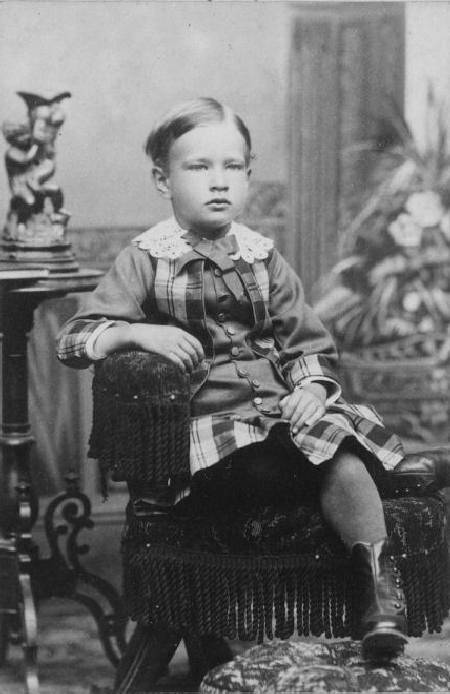
American Boy Dresses: Color and Patterns

Figure 1.--This unidentified boy was from Cambridgeport, Massachusetts. The studio was Whitney. We are unsure how to date the portrait. It was a gold-edged CDV portrait which were not very common in America by the 1880s. We would guess that it was taken about 1880. Note the plaid pattern elements in the dress.
|
|
Color and patterns are of course an important aspects of dresses. We do not know if boy dressed tended to be different colors than girl dresses. We think this is unlikely in the early 19yth or even mid-19th century. It could have been possible in the late-19th century, but we do not yet have the information on colors needed to properly assess this. Assessing color trends is of course difficult using old photographs because they were black and white. There is some color information available in catalogs and paintings, but we have not found a great deal in connection with boy dresses. We do note boys wearing white dresses. This seems to have been a popular color for younger boys. They were also worn seasonally. Patterns are more easilly assessed in the photographic record. Probably the most popular pattern for boys was oplaid because of the connection with Scottih kilts. Other patterns may have been worn by boith girls and boys, but agauin our archive is too limited to make any firm assessments.
We do not know if boy dressed tended to be different colors than girl dresses. We think this is unlikely in the early-19th or even mid-19th century. It could have been possible in the late-19th century, but we do not yet have the information on colors needed to properly assess this. Assessing color trends is of course difficult using old photographs because they were black and white. There is some color information available in catalogs and paintings. Vintage garments are also a valuavble source of color information. We have not yet found a great deal in connection with boy dresses. We do note boys wearing white dresses. White can be identified with a good level of accuracy. We can misled by a very light pastels, we think most of the dresses that looknwehite were actually white. This seems to have been a popular color for younger boys. Colors were to a degree seasonal. White and light colors were popular during the summer. Dark colors were popular for winter wear.
Many different fabric patterns were used in dresses. some dresses were made with plain material, but we notice a varirty of patterns as well. We do not yet have an extensive inventory of the various patterns used in dresses, but have begin to archive examples and collect information. Patterns are of course more easilly assessed in the photographic record. Probably the most popular pattern for boys was plaid because of the connection with Scottih kilts. Plaid was also populsr with girls even though girls did not wear kilts. Other patterns may have been worn by boith girls and boys, but again our archive is too limited to make any firm assessments. We note dresses made in a wide variety of print patterns. There were also dresses with mixed material in which patterns were used as only part of a the dress fabric.
HBC

Navigate the Historic Boys' Clothing Web dress pages:
[Return to the Main U.S. dress page]
[Return to the Main U.S. national dress style page]
[Pinafores]
[Ringlet curls]
[Smocks]
[Bodice kilts]
[Kilts]
[Fauntleroy dresses]
[Sailor dresses]
[Fancy dresses]
[Dresses: 16th-18th centuries]
[Dresses: Early-Mid-19th century]
[Dresses: Late-19th century]
[Dresses: Early 20th century]
[Difficult images]
[Movie dresses]
Navigate the Boys' Historical Clothing Web Site:
[Introduction]
[Activities]
[Biographies]
[Chronology]
[Clothing styles]
[Countries]
[Bibliographies]
[Contributions]
[Essays]
[FAQs]
[Glossaries]
[Images]
[Links]
[Registration]
[Tools]
[Boys' Clothing Home]
Created: 10:01 PM 10/31/2008
Last updated: 7:58 PM 6/27/2010



